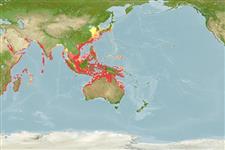Actinopterygii (ray-finned fishes) >
Perciformes (Perch-likes) >
Carangidae (Jacks and pompanos) > Caranginae
Etymology: Parastromateus: Greek, para in the side of + Greek, stromatos = a fish flattened body with a lot of colours (Stromateus sp.) (Ref. 45335).
Environment / Climate / Range
Ecology
Marine; brackish; reef-associated; amphidromous (Ref. 51243); depth range 15 - 105 m (Ref. 12260), usually 15 - 40 m (Ref. 54702). Tropical, preferred 27°C (Ref. 107945); 42°N - 30°S, 32°E - 154°E
Indo-West Pacific: East Africa to southern Japan and Australia.
Length at first maturity / Size / Weight / Age
Maturity: Lm ?, range 22 - 24 cm
Max length : 75.0 cm TL male/unsexed; (Ref. 5284); common length : 30.0 cm TL male/unsexed; (Ref. 3287)
Dorsal
spines
(total): 2 - 6;
Dorsal
soft rays
(total): 41-46;
Anal
spines: 2;
Anal
soft rays: 35 - 40;
Vertebrae: 24. Deep-bodied and strongly compressed fishes. Lateral line ends in weakly-developed scutes on the caudal peduncle. Pelvic fins lost in individuals over 9 cm. Color is brown above, silvery-white below. The anterior parts of the dorsal and anal fins bluish-gray. The other fins yellowish.
Adults inhabit coastal areas with muddy substrate. Found near the bottom during daytime and near the surface at night. They also enter estuaries (Ref. 1479). Normally form large schools (Ref. 5213). Swim on its side near the surface (Ref. 3197). Feed on zooplankton (Ref. 30573). Excellent food fish (Ref. 3197); marketed fresh, may be dried or salted (Ref. 5284).
Paxton, J.R., D.F. Hoese, G.R. Allen and J.E. Hanley, 1989. Pisces. Petromyzontidae to Carangidae. Zoological Catalogue of Australia, Vol. 7. Australian Government Publishing Service, Canberra, 665 p. (Ref. 7300)
IUCN Red List Status (Ref. 115185)
CITES (Ref. 94142)
Not Evaluated
Threat to humans
Harmless
Human uses
Fisheries: highly commercial
Tools
Special reports
Download XML
Internet sources
Estimates of some properties based on models
Phylogenetic diversity index (Ref.
82805): PD
50 = 1.0000 [Uniqueness, from 0.5 = low to 2.0 = high].
Bayesian length-weight: a=0.02512 (0.01986 - 0.03178), b=2.92 (2.86 - 2.98), in cm Total Length, based on LWR estimates for this species (Ref.
93245).
Trophic Level (Ref.
69278): 2.9 ±0.35 se; Based on food items.
Resilience (Ref.
69278): High, minimum population doubling time less than 15 months (K=0.6).
Vulnerability (Ref.
59153): Moderate vulnerability (37 of 100) .
